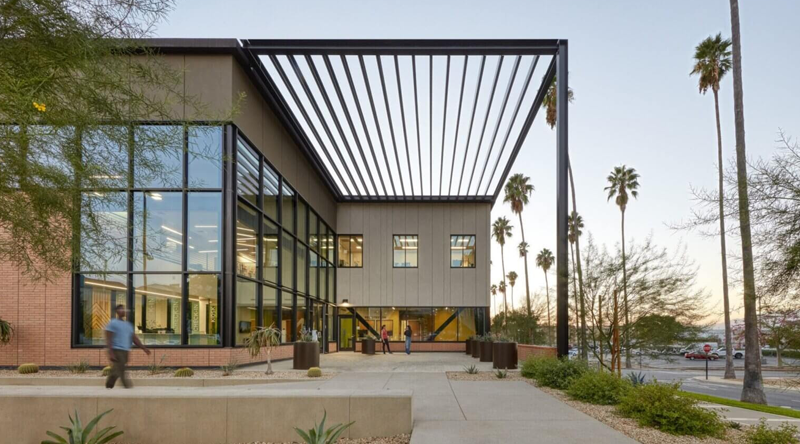By HCO Staff
RIVERSIDE, Calif.—Designed by interdisciplinary firm, HGA, and delivered through a design-build partnership with Turner Construction Company, the new Student Health and Counseling Center at the University of California, Riverside (UC Riverside) is now providing a holistic approach to wellness for students across the University’s campus. Medical, mental health and wellbeing services are integrated throughout the comprehensive two-story, 39,450-square-foot center that includes a primary care clinic, women’s health services, laboratory services, a pharmacy, counseling offices, and a conference center. The University celebrated the state-of-the-art facility’s opening with a ribbon-cutting ceremony.
The new Student Health and Counseling Center (SHCC) has been carefully situated in the northern residential district of the campus, convenient for student access. It replaces the University’s former Student Health Services and Counseling and Psychological Services, which were located in aging 1960’s era buildings south of the new site. Both departments, Student Health and Counseling and Psychological Services are the largest operators in the new Center, which now includes more than double the number of exam rooms and offers a wide array of upgraded spaces to support student health within walking distance from the residence halls.
The new facility offers additional health services in a single location for the first time to complete a seamless wellness experience, including Case Management Services and the Student Well-being, Intervention, and Follow-up Team (SWIFT) that handles crisis response. The Well—UC Riverside’s health promotion and education department—and Basic Needs, which assists students with essential needs and provides for students with food insecurity issues, also have satellite spaces at the new facility. The increased space for medical services results in increased appointment availability for more efficient treatment. To support this, the space also includes a significant technology upgrade, which is being accompanied by a redesigned website where students can easily manage their healthcare.
HGA’s design of the Student Health and Counseling Center relied on evidence-based practices to ensure all departments can work together synergistically within the new healthcare environment. Laboratory services were relocated to be directly adjacent to the clinics for improved connectivity and communication between the clinicians and lab staff and to ensure patients could provide their specimen collection as part of their appointments.
The design also focused on the student experience, providing a modern healing atmosphere for those who are ill and a welcoming space to promote ongoing services and preventative care for students campus wide. Soothing, biophilic design elements contribute to the overall environment with large windows that allow natural light and take advantage of views of the Box Springs Mountains to the east and the Wellness Court and green belt to the south. A custom wood art wall design accents the main lobby reception area and the counseling center features specialty wood ceilings. A spectrum of soft blue, yellow and green pastel colors decorate walls in the first and second floor lobbies, a nod to the calming effects of nature.
The building’s multiple entries provide enhanced accessibility for students, staff, and visitors that arrive at the Center. The main entrance, located on the front of the facility and highly visible from the main thoroughfare of West Linden Street, provides vehicular access and drop-offs. A second entry, located off of the central courtyard, provides easy access for students walking to the Center from the dining and residence halls to the south. A third key entry is provided on the west side of the building, allowing for discreet ambulance access to the facility, for students requiring transport to a local hospital.
The design of the new center achieves the University’s sustainability goals anticipating a LEED Silver certification while addressing environmental concerns through embodied carbon reduction; human health concerns through nutrition programs, improved air quality, acoustics, and the incorporation of biophilic design strategies.


